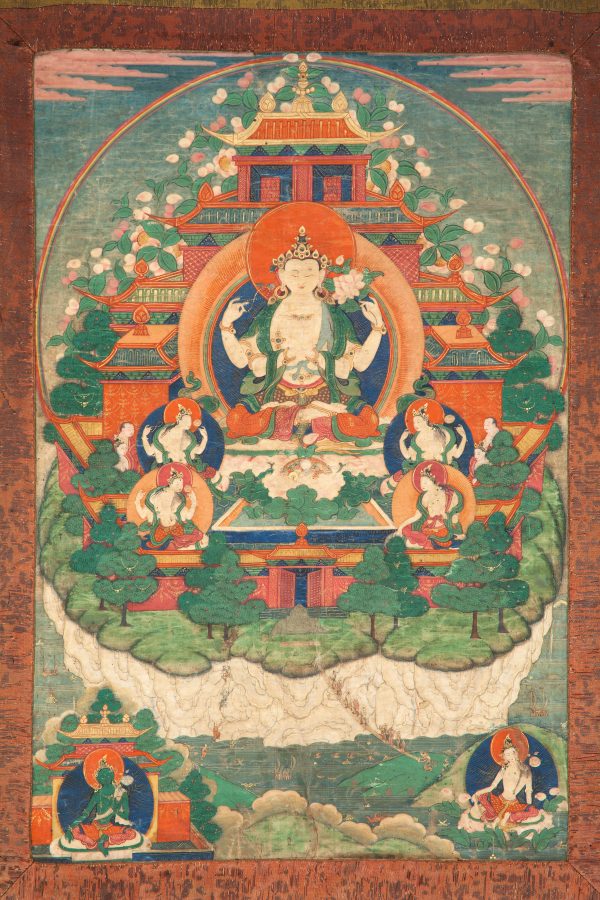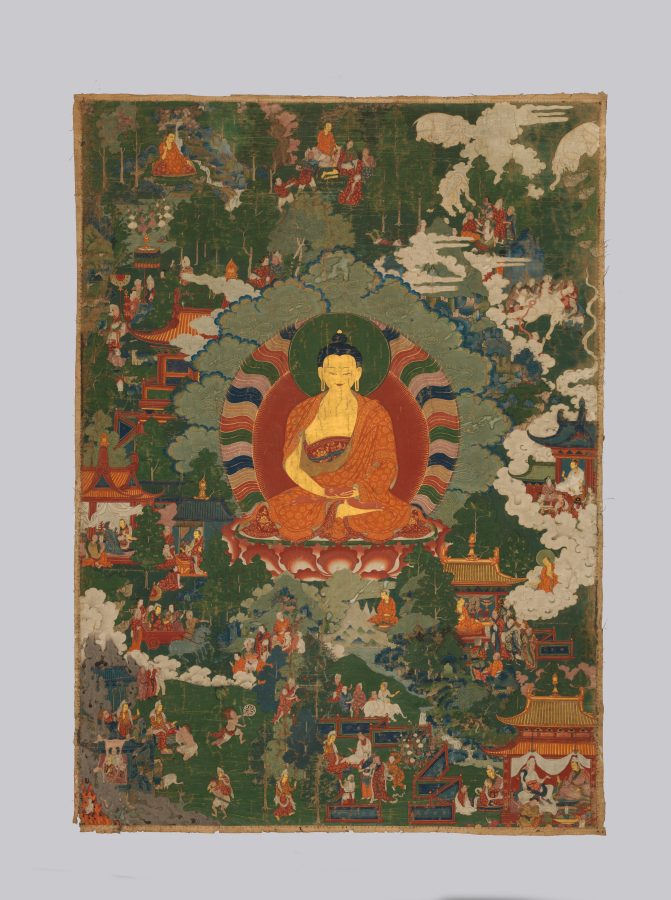The workshop-style training will take place over six days from June 16 to July 2, 2025.
Himalayan art and religious imagination, storytelling in symbolic forms
The institute will open with a program overview by the codirectors and a discussion of methodologies for the days ahead. Kimon Keramidas will present on the Rubin Museum’s ongoing digital projects and how these rich resources and digital media can help in researching and presenting scholarship in teaching. Elena Pakhoutova’s presentation on symbolic visual language and narrative aspects of Himalayan art will facilitate the participants’ discussion of how the fundamentals of Buddhism, Buddhist psychology, and religious practices can be read when presented in visual forms. By addressing the images not as mere illustrations to texts but visual and symbolic narratives in their own right, the intersected conversation from the participating faculty will focus on the following: the ways in which recognizing the main types of figures and decoding their poses and gestures that reveal symbolic connotations can be meaningfully interpreted; how to avoid the pitfalls of essentializing their values removed from cultural contexts; and how relevant interdisciplinary and cross-cultural connections, often hidden within stylistic or iconographic aspects of religious art, can be revealed and expanded in historical, narrative, ritual, and cultural contexts. A participant-facilitated panel discussion will conclude the day with a draft of potential curriculum enhancements and plans for future research presentations or panels.
Representations of the feminine in Himalayan art, ritual, literature, and popular culture
Presentations by Elena Pakhoutova, Jue Liang, and Kerry Lucinda Brown focused on images of female deities will be used as the basis for a concentrated exploration of the divine feminine in Buddhist and Hindu traditions, touching upon gender and its representation in Himalayan art and its connections across Asia. The main themes of the discussion will focus on ideas and attributes of the feminine in Himalayan cultures such as power, wisdom, protection, fertility, prosperity, and well-being as represented in images of peaceful, semi-wrathful, and wrathful females deities and goddess, as well as their relevance to or challenge of contemporary ideas related to women and feminine ideals. A participant-facilitated panel discussion led by Sarah Jacoby will conclude the day with a draft of potential curriculum enhancements and plans for future research papers or panels.
Living practices—cultural and technological connections through art media
This day will focus on material and technological aspects of art production, or technology and its cross-cultural nature. Presentations by Karl Debreczeny and Elena Pakhoutova will invite the participants’ thoughts on technology going hand in hand with the agency of artists, patrons, and users, crossing boundaries and serving as a means for the expansion of ideas, ideologies, artforms, styles, and methods of cultural production. A presentation by Yewong Tenzin Dongchung about woodblock printing in Tibet will be followed by an intersected discussion from participating faculty focused on the technology of mass production in Himalayan cultural and religious spheres and its relevance to the present day. A participant-facilitated panel discussion led by James Gentry will conclude the day with a draft of potential curriculum enhancements and plans for future research papers or panels.
Himalayan art and rituals for sustaining the environment and communities
This day will focus on ritual aspects of Himalayan art as part of religious, social, and communal cultural traditions. A presentation by Todd Lewis will focus on the Newars of the Kathmandu Valley and the communal rather than purely religious character of numerous festivals in Nepal. A presentation by Charles Ramble will focus on religious festivals in other cultural regions, including Tibetan, Bhutanese, and Mongolian areas, where Tibetan Buddhist ritual traditions serve as the foci for communal gatherings that mark important events in the calendar year and are believed to maintain the local communities’ prosperity and well-being. A participant-facilitated panel discussion led by Huatse Gyal will also focus on economy-driven patronage and support for such festivals, including tourism, and will conclude the day with a draft of potential curriculum enhancements and plans for future research papers or panels.
The interdependence of all things—the art of medicine and healing
The Himalayas and Tibetan Plateau are home to rich medical traditions, and the work of maintaining health and dispelling illness occurs within and between the domains that might be understood as “religion” and “science.” This day will start with presentations by Sienna R. Craig and William McGrath focused on the holistic understanding of health and healing that is beyond but inclusive of Buddhist approaches that offer a path toward greater well-being. Wellness as a popular idea has evolved into an industry in the United States, and various current trends promote holistic medicine, often claiming origins in ancient practices. In the broader yet historical context, Tibetan medical practices include knowledge of disease etiology, diagnosis, and treatment that are grounded in textual sources concurrent with the spread of Buddhism across the region; emergent from a pharmacology that reflects histories of trans-Himalayan trade and knowledge exchange; and tied to particular social ecologies, family lineages, and medical institutions. Approaches to healing also include ritual practices to address the root causes of illness—physical, emotional, social, or cosmo-religious—and feature an integrated practice of astrology. A participant-facilitated panel discussion led by Elena Pakhoutova will focus on these topics and will conclude the day with a draft of potential curriculum enhancements and plans for future research papers or panels.
Himalayan art and society—Tibetan Buddhism and empires, religions and nationalism
This day will address topics that are often found controversial and require an informed and careful approach. In his presentation, Karl Debreczeny will focus on images as representations of specific beliefs employed by rulers of Inner Asian empires, from the Tibetan Empire andMongol Empire to the Chinese Ming and Manchu Qing Empires. Presentations by Riga Shakya will touch upon religious nationalism and modernity in Himalayan regions, including Tibetan areas, Nepal, Bhutan, and cross-regional currents. A participant-facilitated panel discussion led by Gray Tuttle will focus on cross-cultural connections that highlight common approaches to religious ideologies as a means for consolidating power. In an open discussion format the presenters will encapsulate the previous days’ discussions into actionable plans for future outcomes. The faculty will be invited to break into six smaller groups but can attend more than one group. Each group will present the results of their discussion to all participants in the full forum, outlining drafts of potential curriculum enhancements and plans for future research papers or panels.
The Rubin Museum’s Virtual Gateway to Himalayan Art and Cultures was developed as a National Endowment for the Humanities (NEH) Institutes for Higher Education program. As of April 2, 2025, this program is no longer supported by the National Endowment for the Humanities.
Any views, findings, conclusions, or recommendations expressed on this Web site or workshop, do not necessarily represent those of the National Endowment for the Humanities.



